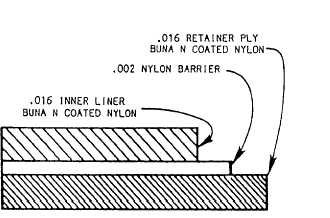

Custom Search
|
|
  |
|
|
Self-Sealing Fuel Cells A self-sealing cell is a fuel container that auto-matically seals small holes or damage caused during combat operations. A self-sealing cell is not bulletproof, merely puncture sealing. As illustrated in figure 3-31, the bullet penetrates the outside wall of the cell, and the sticky, elastic sealing material surrounds the bullet. As the bullet passes through the cell wall into the cell, the sealant springs together quickly and closes the hole. Now some of the fuel in the tank comes in contact with the sealant and makes it swell, completing the seal. In this application, the natural stickiness of rubber and the basic qualities of rubber and petroleum seal the hole. This sealing action reduces the tire hazard brought about
by leaking fuel. It keeps the aircrafts fuel intact so the aircraft may continue operating and return to its base. The most commonly used types of self-sealing fuel cells are the standard construction type and the type that uses a bladder along with the self-sealing cell. Of the two, the standard construction cell is use the most. It is a semiflexible cell, made up of numerous plies of material. The combination bladder and self-sealing cell is made up of two parts. One part is a bladder-type cell, and the other part is identical to the standard construction cell. It is designed to self-seal holes or damage in the bottom and the lower portions of the side areas. The bladder part of the cell (nonself-sealing) is usually restricted to the upper portion. This type of cell is also semi flexible.SELF-SEALING CELL (STANDARD CONSTRUCTION). There are four primary layers of materials used in the construction of a self-sealing cell. These layers are the inner liner, nylon fuel barrier, sealant, and retainer. All self-sealing fuel cells now in service contain these four primary layers of materials. If additional plies are used in the construction of the cell, they will be related to one of the primary plies.The inner liner material is the material used inside the cell. It is constructed of Buna N synthetic rubber. Its purpose is to contain the fuel and prevent it from coming in contact with the sealant. This will prevent premature swelling or deterioration of the sealant. Buna rubber is an artificial substitute for crude or natural rubber. It is produced from butadiene and sodium, and is made in two types, Buna S and Buna N. The Buna S is the most common type of synthetic rubber. It is unsuitable for use as inner liner material in fuel cells. It causes the petroleum fuels used in aircraft to swell and eventually dissolve. The Buna N is not affected by petroleum fuels, making it ideal for this application. However, the Buna N is slightly porous, making it necessary to use a nylon barrier to prevent the fuel from contacting the sealant.The nylon fuel barrier is an unbroken film of nylon. The purpose of the nylon fuel barrier is to prevent the fuel from diffusing farther into the cell. The nylon is brushed, swabbed, or sprayed in three or four hot coats to the outer surface of the inner liner during construction.The sealant material is the next material used in fuel cell construction. It remains dormant in the fuel cell until the cell is ruptured or penetrated by a projectile. It is the function of the sealant to seal the ruptured area. This will keep the fuel from flowing through to the exterior of the fuel cell (fig. 3-31.) The mechanical reaction results because rubber, both natural and synthetic, will "give" under the shock of impact. This will limit damage to a small hole in the fuel cell. The fuel cell materials will allow the projectile to enter or leave the cell, and then the materials will return to their original position. This mechanical reaction is almost instantaneous. The chemical reaction takes place as soon as fuel vapors penetrate through the inner liner material and reach the sealant. The sealant, upon contact with fuel vapors, will extend or swell to several times its normal size. This effectively closes the rupture and prevents the fuel from escaping. The sealant is made from natural gum rubber.
Figure 3-32.Self-sealing fuel cell (standard construction). The retainer material is the next material used in fuel cell construction. The purpose of the retainer is to provide strength and support. It also increases the efficiency of the mechanical action by returning the fuel cell to its original shape when punctured. It is made of cotton or nylon cord fabric impregnated with Buna N rubber.SELF-SEALING CELL (NONSTANDARD CONSTRUCTION). One variation from the standard construction, self-sealing fuel cell previously discussed is shown in figure 3-32. It has four primary layersan inner liner, a nylon fuel barrier, two sealant plies, and three retainer plies.The cords in the first retainer ply run lengthwise of the cell. The cords in the second retainer run at a 45-degree angle to the first. The cords in the third retainer run at a 90-degree angle to the second. The outside is coated with Buns-Vinylite lacquer to protect the cell from spilled fuel and weathering. Baffles and internal bulkheads are used inside the cell to help retain the shape of the cell and prevent sloshing of the fuel. They are constructed of square woven fabric impregnated with Buna N rubber. Flapper valves are fitted to some baffles to control the direction of fuel flow between compartments or interconnecting cells. They are constructed of Micarta, Bakelite, or aluminum.These plies, baffles, internal bulkheads, and flapper valves with the necessary fittings and combinations make up a typical self-sealing fuel cell. Figure 3-33.Bladder cell construction |
 
|
  |
|